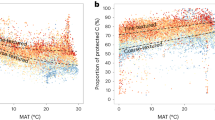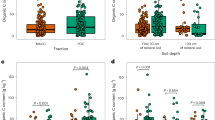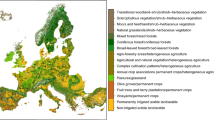Abstract
Effective land-based solutions to climate change mitigation require actions that maximize soil carbon storage without generating surplus nitrogen. Land management for carbon sequestration is most often informed by bulk soil carbon inventories, without considering the form in which carbon is stored, its capacity, persistency and nitrogen demand. Here, we present coupling of European-wide databases with soil organic matter physical fractionation to determine continental-scale forest and grassland topsoil carbon and nitrogen stocks and their distribution between mineral-associated and particulate organic matter pools. Grasslands and arbuscular mycorrhizal forests store more soil carbon in mineral-associated organic carbon, which is more persistent but has a higher nitrogen demand and saturates. Ectomycorrhizal forests store more carbon in particulate organic matter, which is more vulnerable to disturbance but has a lower nitrogen demand and can potentially accumulate indefinitely. The share of carbon between mineral-associated and particulate organic matter and the ratio between carbon and nitrogen affect soil carbon stocks and mediate the effects of other variables on soil carbon stocks. Understanding the physical distribution of organic matter in pools of mineral-associated versus particulate organic matter can inform land management for nitrogen-efficient carbon sequestration, which should be driven by the inherent soil carbon capacity and nitrogen availability in ecosystems.
This is a preview of subscription content, access via your institution
Access options
Access Nature and 54 other Nature Portfolio journals
Get Nature+, our best-value online-access subscription
$29.99 / 30 days
cancel any time
Subscribe to this journal
Receive 12 print issues and online access
$259.00 per year
only $21.58 per issue
Buy this article
- Purchase on Springer Link
- Instant access to full article PDF
Prices may be subject to local taxes which are calculated during checkout





Similar content being viewed by others
Data availability
Data from the LUCAS database can be accessed at http://esdac.jrc.ec.europa.eu/content/lucas-2009-topsoil-data. The fractionation data will be made available at the European Soil Data Centre of the EU Joint Research Centre website (https://esdac.jrc.ec.europa.eu/). The tree occurrence dataset can be also downloaded from https://doi.org/10.6084/m9.figshare.c.3288407, associated with the paper by Mauri et al.21. The final dataset is available from the European Soil Data Centre of the European Commission: https://esdac.jrc.ec.europa.eu/content/soil-organic-matter-som-fractions. Requests for data can be addressed to E.L. (Emanuele.LUGATO@ec.europa.eu).
Code availability
The R scripts are available from the European Soil Data Centre (ESDAC) of the European Commission: https://esdac.jrc.ec.europa.eu/content/soil-organic-matter-som-fractions.
References
IPCC Climate Change 2013: The Physical Science Basis (eds Stocker T. F. et al.) (Cambridge Univ. Press, 2013).
Chabbi, A. et al. Aligning agriculture and climate policy. Nat. Clim. Change 7, 307–309 (2017).
Wiesmeier, M. et al. Soil organic carbon storage as a key function of soils—a review of drivers and indicators at various scales. Geoderma 333, 149–162 (2019).
Gong, P. et al. Finer resolution observation and monitoring of global land cover: first mapping results with Landsat TM and ETM+ data. Int. J. Remote Sens. 34, 2607–2654 (2013).
Jobbagy, E. G. & Jackson, R. B. The vertical distribution of soil organic carbon and its relation to climate and vegetation. Ecol. Appl. 10, 423–436 (2000).
Janzen, H. The soil carbon dilemma: shall we hoard it or use it? Soil Biol. Biochem. 38, 419–424 (2006).
Schlesinger, W. H. & Amundson, R. Managing for soil carbon sequestration: let’s get realistic. Glob. Change Biol. 25, 386–389 (2018).
Averill, C., Turner, B. L. & Finzi, A. C. Mycorrhiza-mediated competition between plants and decomposers drives soil carbon storage. Nature 505, 543–545 (2014).
Zak, D. R., Freedman, Z. B., Upchurch, R. A., Steffens, M. & Kögel-Knabner, I. Anthropogenic N deposition increases soil organic matter accumulation without altering its biochemical composition. Glob. Change Biol. 23, 933–944 (2017).
Mack, M. C., Schuur, E. A. G., Bret-Harte, M. S., Shaver, G. R. & Chapin, F. S. I. I. I. Ecosystem carbon storage in Arctic tundra reduced by long-term nutrient fertilization. Nature 431, 440–443 (2004).
Cotrufo, M. F. et al. Soil organic matter formation from biochemical and physical pathways of litter mass loss. Nat. Geosci. 8, 776–779 (2015).
Castellano, M., Mueller, K., Olk, D., Sawyer, J. & Six, J. Integrating plant litter quality, soil organic matter stabilization and the carbon saturation concept. Glob. Change Biol. 21, 3200–3209 (2015).
Averill, C. & Waring, B. Nitrogen limitation of decomposition and decay: how can it occur? Glob. Change Biol. 24, 1417–1427 (2018).
Golchin, A., Oades, J., Skjemstad, J. & Clarke, P. Study of free and occluded particulate organic matter in soils by solid state 13C Cp/MAS NMR spectroscopy and scanning electron microscopy. Soil Res 32, 285–309 (1994).
Kogel-Knabner, I. et al. Organo-mineral associations in temperate soils: integrating biology, mineralogy, and organic matter chemistry. J. Plant Nutr. Soil Sci. 171, 61–82 (2008).
Poeplau, C. et al. Isolating soil organic carbon fractions with varying turnover rates—a comprehensive comparison of fractionation schemes. Soil Biol. Biochem. 125, 10–26 (2018).
Cambardella, C. A. & Elliott, E. T. Particulate soil organic-matter changes across a grassland cultivation sequence. Soil Sci. Soc. Am. J. 56, 777–783 (1992).
Six, J., Conant, R. T., Paul, E. A. & Paustian, K. Stabilization mechanisms of soil organic matter: implications for C-saturation of soils. Plant Soil 241, 155–176 (2002).
Stewart, C. E., Paustian, K., Conant, R. T., Plante, A. F. & Six, J. Soil carbon saturation: concept, evidence and evaluation. Biogeochemistry 86, 19–31 (2007).
Toth, G., Jones, A. & Montanarella, L. LUCAS Topsoil Survey Methodology, Data and Results (European Union, 2013).
Mauri, A., Strona, G. & San-Miguel-Ayanz, J. EU-Forest, a high-resolution tree occurrence dataset for Europe. Sci. Data 4, 160123 (2017).
Batjes, N. H. Total carbon and nitrogen in the soils of the world. Eur. J. Soil Sci. 65, 10–21 (2014).
Sterner, R. W. & Elser, J. J. Ecological Stochiometry: The Biology of Elements from Molecules to the Biosphere (Princeton Univ. Press, 2002).
Paul, E. A. Soil Microbiology, Ecology and Biochemistry (Academic, 2014).
Weedon, J. T. et al. Global meta-analysis of wood decomposition rates: a role for trait variation among tree species? Ecol. Lett. 12, 45–56 (2009).
Liang, C., Schimel, J. P. & Jastrow, J. D. The importance of anabolism in microbial control over soil carbon storage. Nat. Microbiol 2, 17105 (2017).
Mueller, C. W. et al. Submicron scale imaging of soil organic matter dynamics using NanoSIMS—from single particles to intact aggregates. Org. Geochem. 42, 1476–1488 (2012).
Fernandez, C. W., Langley, J. A., Chapman, S., McCormack, M. L. & Koide, R. T. The decomposition of ectomycorrhizal fungal necromass. Soil Biol. Biochem. 93, 38–49 (2016).
Gadgil, R. L. & Gadgil, P. D. Mycorrhiza and litter decomposition. Nature 233, 133 (1971).
Freschet, G. T., Aerts, R. & Cornelissen, J. H. C. A plant economics spectrum of litter decomposability. Funct. Ecol. 26, 56–65 (2012).
Van Groenigen, J. W. et al. The soil N cycle: new insights and key challanges. SOIL 1, 235–256 (2015).
Phillips, R. P., Brzostek, E. & Midgley, M. G. The mycorrhizal-associated nutrient economy: a new framework for predicting carbon–nutrient couplings in temperate forests. New Phytol. 199, 41–51 (2013).
Craig, M. E. et al. Tree mycorrhizal type predicts within-site variability in the storage and distribution of soil organic matter. Glob. Change Biol. 24, 3317–3330 (2018).
Denef, K., Del Galdo, I., Venturi, A. & Cotrufo, M. F. Soil carbon and nitrogen stocks and distribution across organic matter fractions in European soils under different land use. Open J. Soil Sci. 3, 297–313 (2013).
Fierer, N. Embracing the unknown: disentangling the complexities of the soil microbiome. Nat. Rev. Microbiol. 15, 579–590 (2017).
Angers, D., Arrouays, D., Saby, N. & Walter, C. Estimating and mapping the carbon saturation deficit of French agricultural topsoils. Soil Use Manag. 27, 448–452 (2011).
Wang, B. & Qiu, Y. L. Phylogenetic distribution and evolution of mycorrhizas in land plants. Mycorrhiza 16, 299–363 (2006).
Harris, D., Horwáth, W. R. & van Kessel, C. Acid fumigation of soils to remove carbonates prior to total organic carbon or carbon-13 isotopic analysis. Soil Sci. Soc. Am. J. 65, 1853–1856 (2000).
Simpson, D. et al. The EMEP MSC-W chemical transport model—technical description. Atmos. Chem. Phys. 12, 7825–7865 (2012).
Antal, E. & Tillé, Y. A direct bootstrap method for complex sampling designs from a finite population. J. Am. Stat. Assoc. 106, 534–543 (2011).
Rosseel, Y. Lavaan: an R package for structural equation modeling and more v.0.5–12 (BETA). J. Stat. Softw. 48, 1–36 (2012).
Acknowledgements
We thank A. Mauri, G. Strona and J. San-Miguel-Ayanz for provision of forests data. We thank C. Tuminello for assisting with soil analysis. This work was supported by the JRC (purchase order no. D.B720517), through an OECD Co-operative Research Programme: Biological Resource Management for Sustainable Agricultural Systems fellowship and the NSF-DEB project no. 1743237.
Author information
Authors and Affiliations
Contributions
M.F.C., E.L. and J.S. developed the research concepts. E.L. and M.G.R. conducted the data and statistical analyses. M.L.H. performed the soil analyses. M.F.C., E.L. and J.S. interpreted the data and wrote the paper with contributions from M.G.R. and M.L.H.
Corresponding author
Ethics declarations
Competing interests
The authors declare no competing interests.
Additional information
Peer review information Primary Handling Editor(s): Xujia Jiang.
Publisher’s note Springer Nature remains neutral with regard to jurisdictional claims in published maps and institutional affiliations.
Supplementary information
Supplementary Information
Supplementary Figs. 1–8 and Tables 1–4.
Rights and permissions
About this article
Cite this article
Cotrufo, M.F., Ranalli, M.G., Haddix, M.L. et al. Soil carbon storage informed by particulate and mineral-associated organic matter. Nat. Geosci. 12, 989–994 (2019). https://doi.org/10.1038/s41561-019-0484-6
Received:
Accepted:
Published:
Issue Date:
DOI: https://doi.org/10.1038/s41561-019-0484-6
This article is cited by
-
Responses of soil organic carbon to climate extremes under warming across global biomes
Nature Climate Change (2024)
-
Emergent temperature sensitivity of soil organic carbon driven by mineral associations
Nature Geoscience (2024)
-
Geomorphic controls on the abundance and persistence of soil organic carbon pools in erosional landscapes
Nature Geoscience (2024)
-
Crop-Soil-Environment Benefits of Equivalent Carbon Input from Organic Amendments in Rice Production Ecosystems
Journal of Soil Science and Plant Nutrition (2024)
-
Erosion and deposition controlling redistribution and biodegradation of nitrogen fractions along a Mollisol agricultural landscape
Journal of Soils and Sediments (2024)



